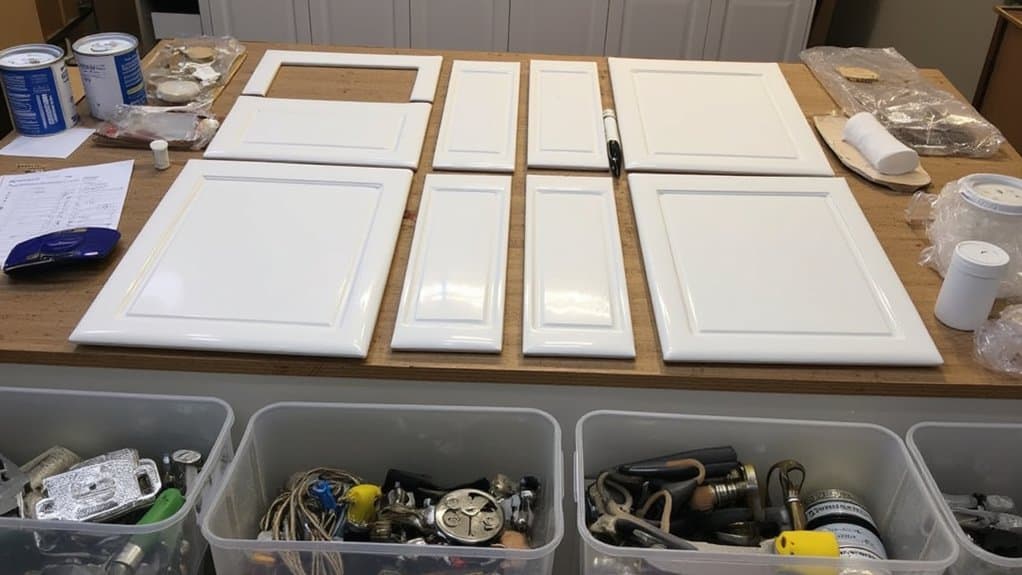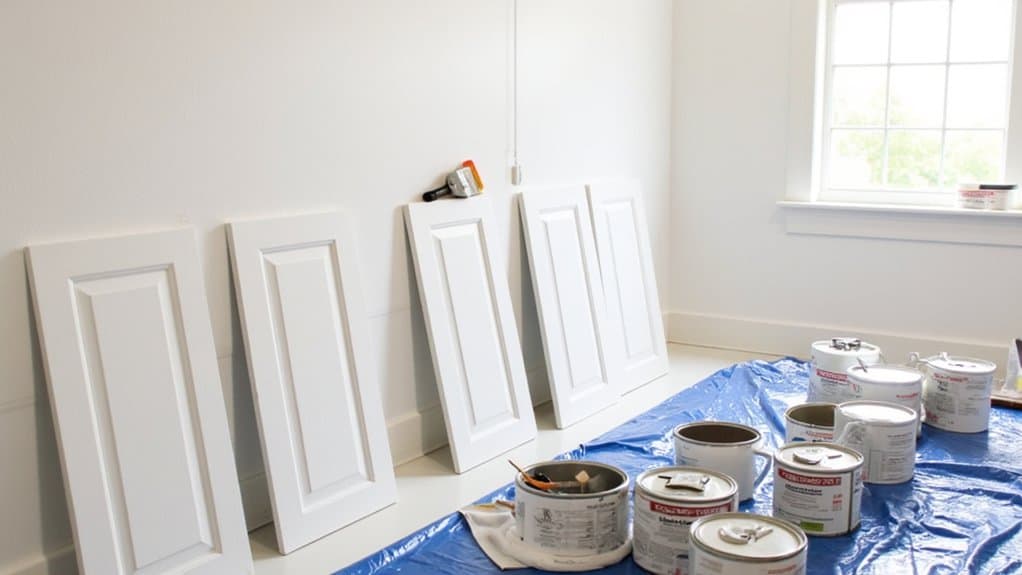Let’s say giving your kitchen a fresh face with white cabinets is a smart way to update your space. You’re likely wondering about the costs involved in this project. Factors like cabinet size, paint quality, and labor rates can vary widely, typically ranging from $50 to $100 per hour for professionals. Stick around to explore a detailed breakdown of expenses and tips to keep your budget in check.
Value of White Cabinets
Elegance often defines a kitchen’s appeal, and white cabinets can instantly elevate that charm with a timeless look. You’ll notice how they brighten your space, reflecting light for a spacious feel, especially in kitchens under 200 square feet.
Why Choose White Cabinets?
- Versatility: Pair them with any countertop, from granite to quartz.
- Durability: They hide minor scuffs better than darker shades if sealed properly.
- Classic Style: White suits traditional or modern designs, never going out of fashion.
When you paint, guarantee a smooth finish by sanding surfaces first, using a primer, and applying two even coats for lasting appeal.
Factors Affecting the Cost

Moving from the appeal of white cabinets, let’s focus on what influences the cost of painting them. Several factors impact your budget, and understanding them helps you plan.
Key Cost Factors
- Cabinet Size and Number: More cabinets mean higher costs. A standard 10×10 kitchen often has 20 cabinets.
- Condition: If cabinets need repairs or heavy sanding, you’ll pay more for prep work.
- Labor Rates: Hiring pros varies by location; urban areas often charge $50-$80 per hour.
- Surface Area: Larger doors or intricate designs increase time and cost. Assess these to estimate expenses accurately.
Paint Cost Analysis
When analyzing paint costs for your kitchen cabinets, start by focusing on quality paint selection, as premium brands often range from $30 to $60 per gallon for durability. Don’t overlook the importance of a primer coat, which can cost $15 to $25 per gallon and guarantees better adhesion for that crisp white finish. Finally, consider your topcoat finish options, like matte or satin, which vary from $20 to $50 per gallon and affect both look and wear.
Quality Paint Selection
As you immerse yourself in painting your kitchen cabinets white, selecting high-quality paint is essential for a durable, professional finish that lasts. Don’t skimp on quality; cheap paints often fade or chip quickly.
Why Quality Matters
- High-quality paint offers better coverage, often needing fewer coats.
- It resists stains and scratches, ideal for busy kitchens.
- Expect to pay $30–$60 per gallon for premium brands.
Choosing the Right Paint
Opt for a semi-gloss or satin finish for easy cleaning. Check for low-VOC options to minimize fumes. Invest wisely, and your cabinets will look stunning for years.
Primer Coat Importance
Before you apply that beautiful white paint to your kitchen cabinets, take a moment to understand why a primer coat matters so much. Primers create a smooth base, ensuring better adhesion and hiding old colors or stains effectively.
Why Primer Saves Money
- Coverage: One coat of primer, about $20-$30 per gallon, reduces the need for multiple paint layers.
- Durability: It seals surfaces, preventing peeling on wood or laminate.
- Cost Efficiency: Spending $25 upfront can save $50 in extra paint.
Apply primer evenly with a brush or roller for a flawless foundation.
Topcoat Finish Options
While a solid primer sets the foundation, choosing the right topcoat finish for your kitchen cabinets determines both the look and longevity of your white paint job. You’ve got options like satin, semi-gloss, and high-gloss, each with different durability and cost.
Topcoat Choices and Costs:
- Satin ($30–$50/gallon): Offers a soft sheen, resists scratches, and suits most kitchens.
- Semi-Gloss ($35–$60/gallon): More durable, easy to clean, ideal for high-traffic areas.
- High-Gloss ($40–$70/gallon): Super shiny, toughest against wear, but shows imperfections.
Pick based on your budget and kitchen use for lasting results.
Hourly Labor Rates
When considering hourly labor rates for painting your kitchen cabinets white, start by comparing the costs of doing it yourself versus hiring a pro. You’ll find that DIY can save you money, often costing $0 since it’s your time, while professional painters might charge between $50 and $100 per hour. Also, keep in mind factors like experience, location, and project size, as these can impact the total labor costs considerably.
Cost Comparison: DIY Vs Pro
Several factors influence the cost of painting kitchen cabinets white, and one major aspect is deciding between a DIY approach or hiring a professional, particularly when considering hourly labor rates. If you’re tackling it yourself, you’ll save on labor but spend $0 per hour of your time. Professionals, however, charge between $50 and $100 per hour, depending on experience and location.
Cost Breakdown:
- DIY: $0/hour (your time).
- Professional: $50-$100/hour, averaging 10-20 hours for a standard kitchen.
Hiring a pro guarantees quality, but DIY cuts costs if you’ve got the skills and patience.
Factors Impacting Labor Costs
Beyond the basic hourly rates, you’ll find that several factors can drive up or lower the labor costs for painting kitchen cabinets white. Labor rates typically range from $50 to $100 per hour, depending on your location and the painter’s experience.
Key Influences on Rates:
- Location: Urban areas often charge more due to higher demand.
- Skill Level: Experienced painters cost more but deliver quality.
- Project Size: Larger kitchens with more cabinets take extra time.
Check local rates and get multiple quotes to budget accurately for your cabinet painting project.
Additional Costs to Consider
As you plan to paint your kitchen cabinets white, don’t overlook the extra costs that can add up beyond just paint and labor. These expenses can impact your total budget if you’re not prepared.
Consider these additional costs:
- Primer: Expect to spend $20–$40 per gallon for quality primer to guarantee paint adhesion.
- Sandpaper and Tools: Budget $10–$25 for sandpaper, brushes, or rollers for surface prep.
- Drop Cloths: Protect floors with cloths costing $15–$30.
- Cabinet Hardware: Replacing knobs or hinges might add $50–$100.
Plan for these to avoid surprises in your project budget.
Budget-Friendly Alternatives
Let’s shift focus to ways you can save money while still transforming your kitchen cabinets to a fresh white look. Painting cabinets yourself is a smart, cost-effective option if you’re willing to invest time.
DIY Painting Tips:
- Prep Properly: Sand surfaces lightly for better paint adhesion, using 120-grit sandpaper.
- Choose Affordable Paint: Opt for a gallon of quality latex paint, around $30-$40.
- Reuse Supplies: Use existing brushes or rollers if they’re clean.
Cost Breakdown:
- Paint: $35
- Sandpaper: $5
- Brushes/Rollers: $10 (if needed)
Total: $50, saving you hundreds compared to professional services.
Conclusion
While transforming your kitchen cabinets to a crisp white can seem challenging, you’ve got the tools and tips to make it happen affordably. With careful planning, you can keep costs between $200 and $500 for a standard 10×10 kitchen, covering paint, primer, and supplies.
Final Steps to Success
- Inspect your work for even coverage; touch up as needed.
- Reattach hardware and doors after 48 hours of drying.
- Budget wisely, prioritizing quality paint for durability.
Stick to this approach, and you’ll achieve a professional white finish without breaking the bank or sacrificing quality.


